Baby Food Can Be Fun: Enjoy Bites with Fermented Touches
Apr 15,2021
Baby Food Can Be Fun: Enjoy Bites with Fermented Touches
Apr 15,2021
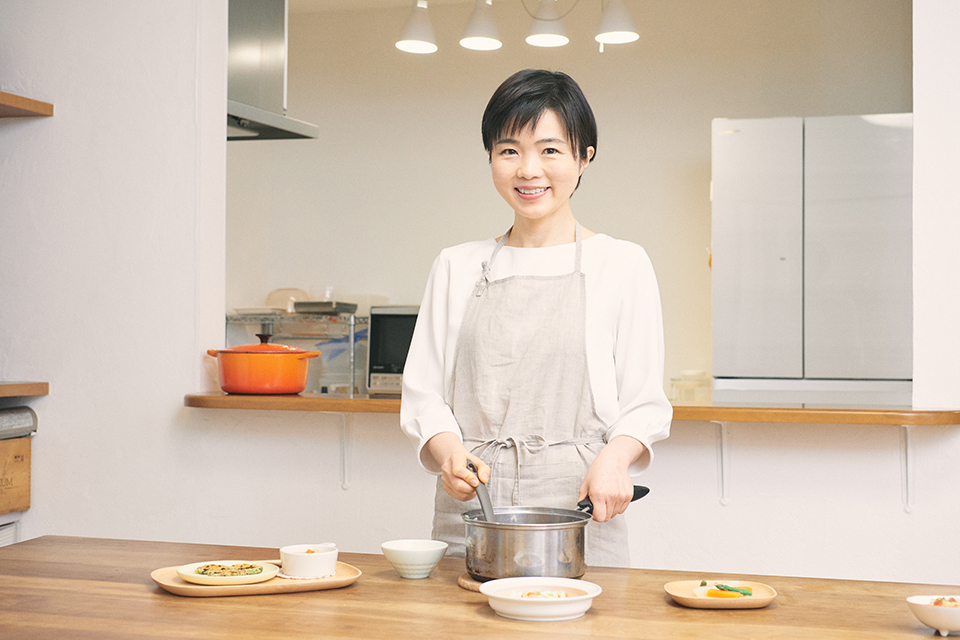

As babies approach six months of age, the topic arises of starting them on solid foods. Watching your little one grow should be a joy, but for a fair number of moms and dads it’s a source of pressure. They’re not sure if they’re up to the task. They’re almost too determined to do the right thing for their child.
Rather than focusing on preparing food for their baby, moms should treasure the time spent eating with them. So advises registered dietitian and culinary expert Nakamura Miho. You might as well enjoy those precious moments. Make them about the future, not just the here and now.
Here, Miho talks about how to take a more relaxed approach to introducing solid foods in a way that respects your baby’s wishes. She also shares several fermented baby food recipes that are an easy, delicious source of nutrition.
Here’s Part 2:
Make Baby Food Fun: Mealtime with Fermented Touches
When starting their baby on solid food, many Japanese parents refer to how-to guides or pamphlets distributed by the local municipality. But if you treat such sources as rulebooks to be followed to the letter, “you’ll be alarmed when your child strays from them even a little,” Miho cautions.
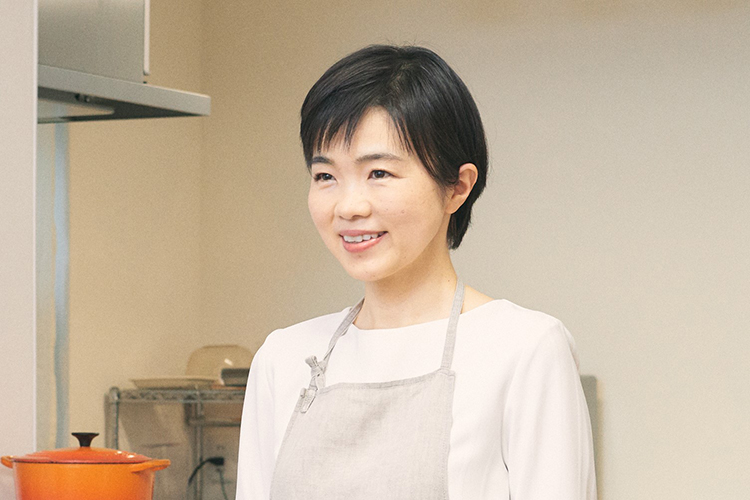
Registered dietitian and culinary expert Nakamura Miho
“Each child is different in what foods they like and dislike and how much they eat, just as some adults are big eaters and others are small eaters. There are considerable individual differences in a child’s development at this stage. When you see exact numbers, like a baby eats such-and-such an amount at so many months, you can’t help becoming concerned. But the information you see in books are simply ballpark figures. Especially when your baby has just started weaning, they still get their basic nutrients from breastmilk or baby formula, so you don’t need to get too uptight.”
At this stage, focus on helping your child become a more experienced eater by increasing their exposure to food. That will develop their eating skills and independence. One way to accomplish that is baby-led weaning (BLW), a method that Miho follows herself. This is a dietary approach that originated in Britain. In Japan, parents typically spoon-feed their children. BLW, by contrast, leaves it up to the baby to decide how much to eat, at what pace, and in what order. That way, feeding doesn’t have to be an emotional roller coaster. There’s no need to get upset just because your baby won’t eat.
“At first, they may just play with their food or drop it everywhere. But they learn on their own as they eat more meals, and soon they’ll start picking up their food and putting it in their mouth. Watching your child enjoy eating is a heartwarming sight. And as long as you’re careful about safety, they can share what the grownups are eating, which makes preparing meals easier. Plus the whole family gets to eat together at the same table, which is another big advantage.”
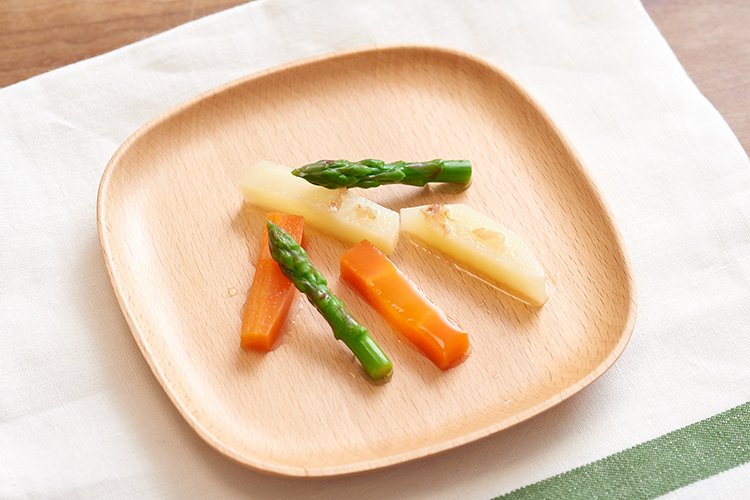
Forget the old notion that you have to spoon-feed your baby. From the age of six months, your baby can feed themselves using their fingers. Keeping finger food in mind as an option lets you breathe easier as a mother or father. You can concentrate on watching your child grow rather than feeding them all the time.
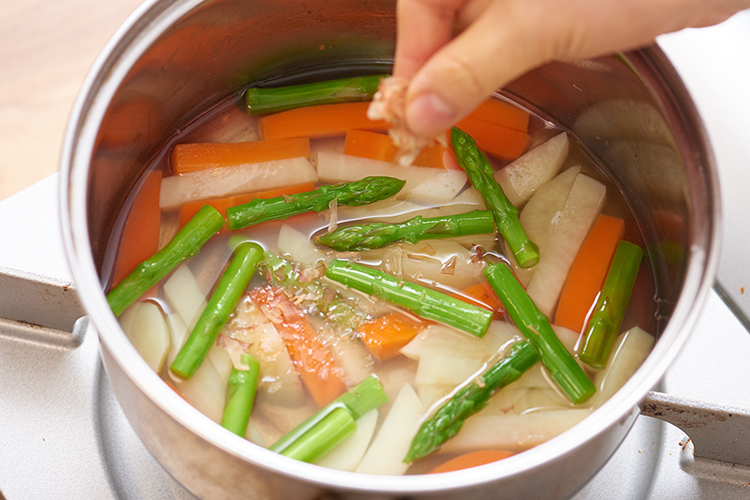
“The trick is to make the vegetable sticks just long enough that the ends protrude slightly when your baby holds them in their hand. When giving your baby the sticks, keep an eye on them to make sure they don’t put too many in their mouth or choke on them. These sticks can also be mashed and mixed into rice porridge. And they can be eaten by the whole family.”
Preparing dashi stock is an important part of Japanese culinary culture. People in Japan tend to believe that dashi stock and soup are essential to making baby foods. But if the umami from the stock is too intense, it may blur the flavor of the ingredients it was meant to accentuate, which would be self-defeating.
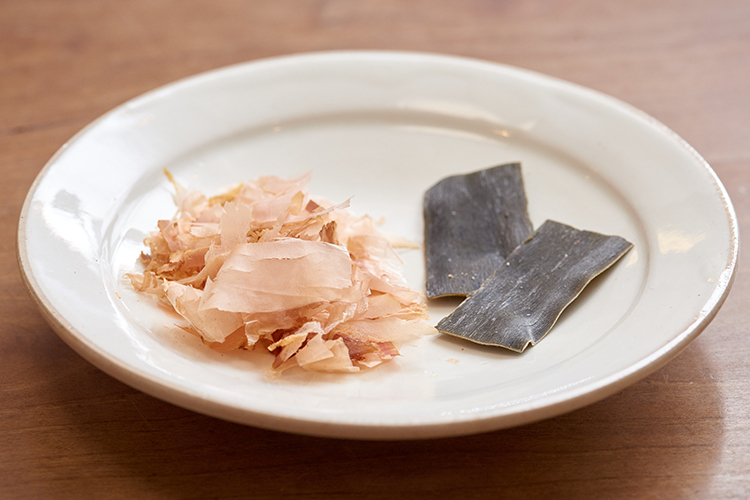
“When making baby foods, the most important thing is to familiarize your baby with the taste of the ingredients. So there’s no need to go out of your way to prepare dashi stock. For starters, a child’s taste buds are much more sensitive than an adult’s. So it’s sufficient to add kombu cut into small pieces and give everything a quick simmer, as in this recipe, or sprinkle on katsuobushi flakes. Be especially careful with the instant dashi sold in stores. If you follow the instructions on the label, the stock will be too salty for your baby.”
Ingredients that are rich in umami in their own right, such as shirasu-boshi (dried baby sardines), help you make baby foods without having to concern yourself too much with preparing stock.
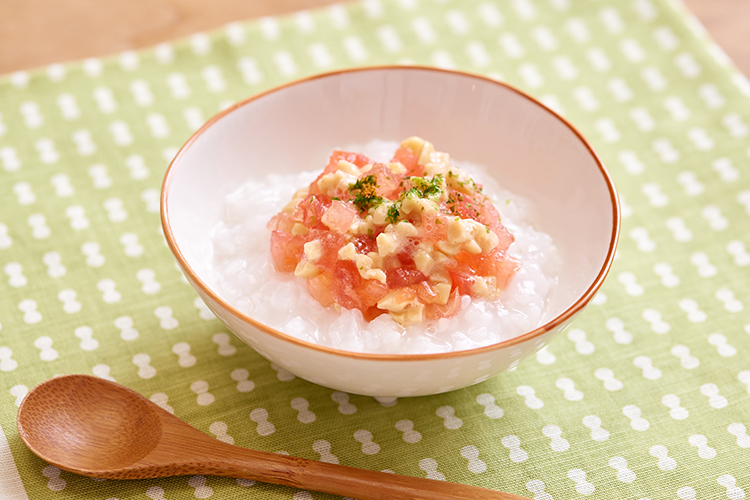
Foods that could potentially boost immunity are in the spotlight these days, and more and more families are making fermented foods part of their meals. One of them is natto (fermented soybeans), which is convenient to use. Because it’s highly nutritious, many moms and dads would love to find a good way to incorporate it into baby foods.
The second recipe that Miho shares with us, therefore, is for a fermented baby food made with natto. It’s a handy source of protein for your baby.
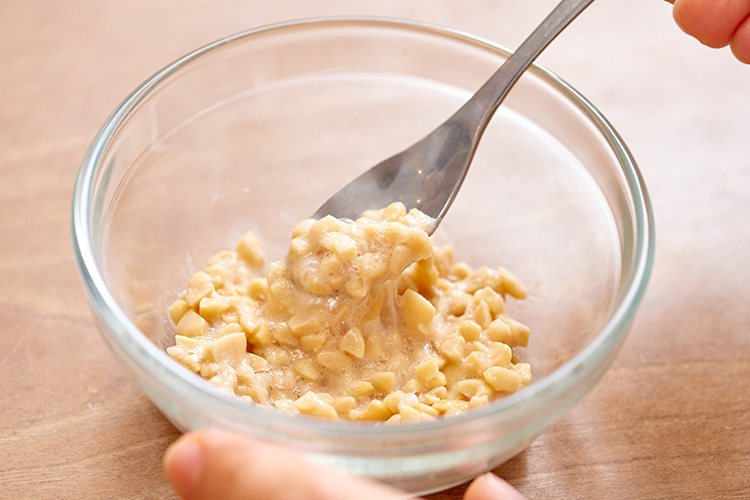
If you boil or mash natto when feeding it to your baby, it leaves a sticky residue, so cleaning up afterward can be a lot of work. Sprinkling natto with water and warming it in the microwave is a simple way to make it baby-friendly. Mixing it with tomato is also part of the trick. It eliminates the peculiar smell, helping the natto go down more easily.
Another great idea is adapting this combination of natto and tomato for adults by, say, topping it with chilled tofu. Meals for grown-ups often end up taking a back seat to the baby’s. But a healthy, happy mom and dad are good for baby’s growth.
“It saves you the trouble of preparing a separate dish for the grown-ups. And when your baby sees the adults heartily eating the same thing as they’re having, it makes them more eager to eat as well.”
When you start your baby on solid foods, it’s all too easy to get carried away worrying about the next meal. But look at it a different way, Miho advises. Every meal is simply one of many that your child will eat over the course of their long life.
“Every child differs in when they start eating solids and whether they’re picky about their food. There are no right answers when it comes to eating. It’s surprising how much you can learn from your little one. Try to see the big picture. Meals are about the future. Focus on enjoying them together.”

As a dietitian at a preschool, Nakamura Miho prepared meals for babies and small children and taught about nutrition. She was also involved in community parenting support programs. Since striking out on her own in 2009, she has run her own cooking school and taught classes in making baby foods. Her motto is “making mealtimes more delicious and enjoyable.” Besides giving seminars on nutrition, she also supervises recipes for books, magazines, and television.